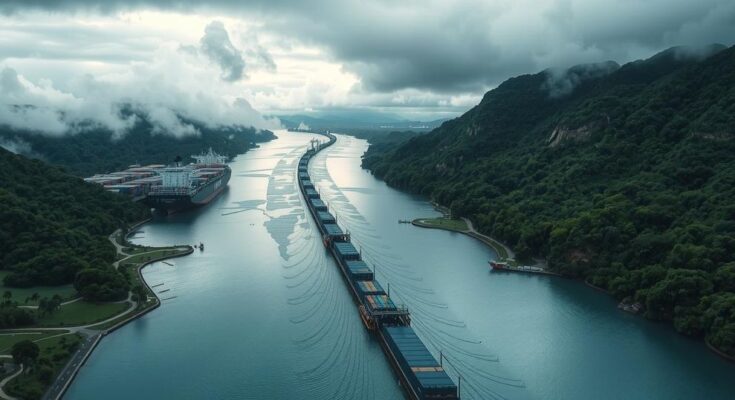The Panama Canal, vital for global trade, faces operational challenges from changing rainfall patterns and climate change. The last few decades have recorded unprecedented dry years impacting traffic and operations. Research projects aim to manage these effects, with a hopeful outlook for improved conditions in the future as Lake Gatun’s water levels rise, ensuring smoother shipping transactions.
The Panama Canal, an essential global shipping route spanning approximately 82 kilometers, connects the Pacific Ocean to the Caribbean Sea and has been crucial for trade since its inauguration in 1914. This year, it has garnered renewed political attention, particularly from figures such as President Donald Trump and Secretary of State Marco Rubio, who advocate for U.S. ownership reclamation.
Recent years have seen the Canal’s operations significantly influenced by changing rainfall patterns due to climate variations. With climate change potentially impacting rainfall patterns further, shipping delays and decreased traffic might become more frequent, posing challenges to the reliability of this vital waterway.
The Canal operates through a series of locks that allow for significant elevation changes, facilitating the passage of diverse vessels including Neopanamax ships, which can carry over 13,000 standard containers. This efficient process, taking 8 to 10 hours, provides substantial savings in both time and fuel cost, particularly when compared to routes around South America.
Mark Russo, chief science officer at Everstream Analytics, emphasizes the Canal’s importance, stating, “Five percent of shipping globally traverses the Panama Canal. It is a critical artery for global trade.” Rainfall is vital for maintaining water levels in Gatun Lake, essential for safe navigation.
Gatun Lake loses significant water due to evaporation, supply for local drinking water, and operational demands of the Canal, extracting approximately 7 billion liters daily for lock operations. Panama typically receives over 2,000 millimeters of rainfall annually; however, the past three decades have seen periods of insufficient rainfall, notably during 1998, 2016, and 2024.
Steve Paton from the Smithsonian Tropical Research Institute notes that these water-scarce years, occurring every two decades, present unprecedented clustering in the region’s rainfall record spanning 144 years. Such water shortages have led to significant reductions in Canal traffic and limitations on ships’ maximum drafts, resulting in longer wait times at locks.
The interconnection between El Niño events and local precipitation levels is crucial, as recent droughts correspond with these warm oceanic phases, which historically result in decreased rainfall. Michael McPhaden from NOAA indicates ongoing research is necessary to understand the intricacies of these climate patterns and their effects on the Canal.
Global warming is intensifying storm events, with predictions for a future increase in storm severity. This could lead to further challenges for the Canal, as excessive rain may jeopardize infrastructure, as seen in the catastrophic 2010 shutdown due to unprecedented rainfall threatening crucial dam structures.
To address these challenges, research efforts, such as the Agua Salud Project managed by the Smithsonian, focus on understanding the watershed’s hydrology. Healthy forest cover is essential for regulating rainwater absorption and release, thus stabilizing water levels in Gatun Lake and protecting the future of Canal operations.
Despite recent challenges, prospects for 2025 appear promising with Gatun Lake water levels currently the highest they have been in five years, instilling hope for improved shipping traffic through the Panama Canal.
The Panama Canal remains a vital link in global trade, but its future operations are closely tied to climatic variations, particularly precipitation levels influenced by cycles such as El Niño. Recent studies highlight an unprecedented clustering of dry years, leading to reduced shipping traffic and operational challenges. Projects to understand and mitigate these impacts are underway, with optimism for improved conditions in the upcoming years. The Canal’s management must remain proactive to navigate the challenges presented by climate change.
Original Source: eos.org




